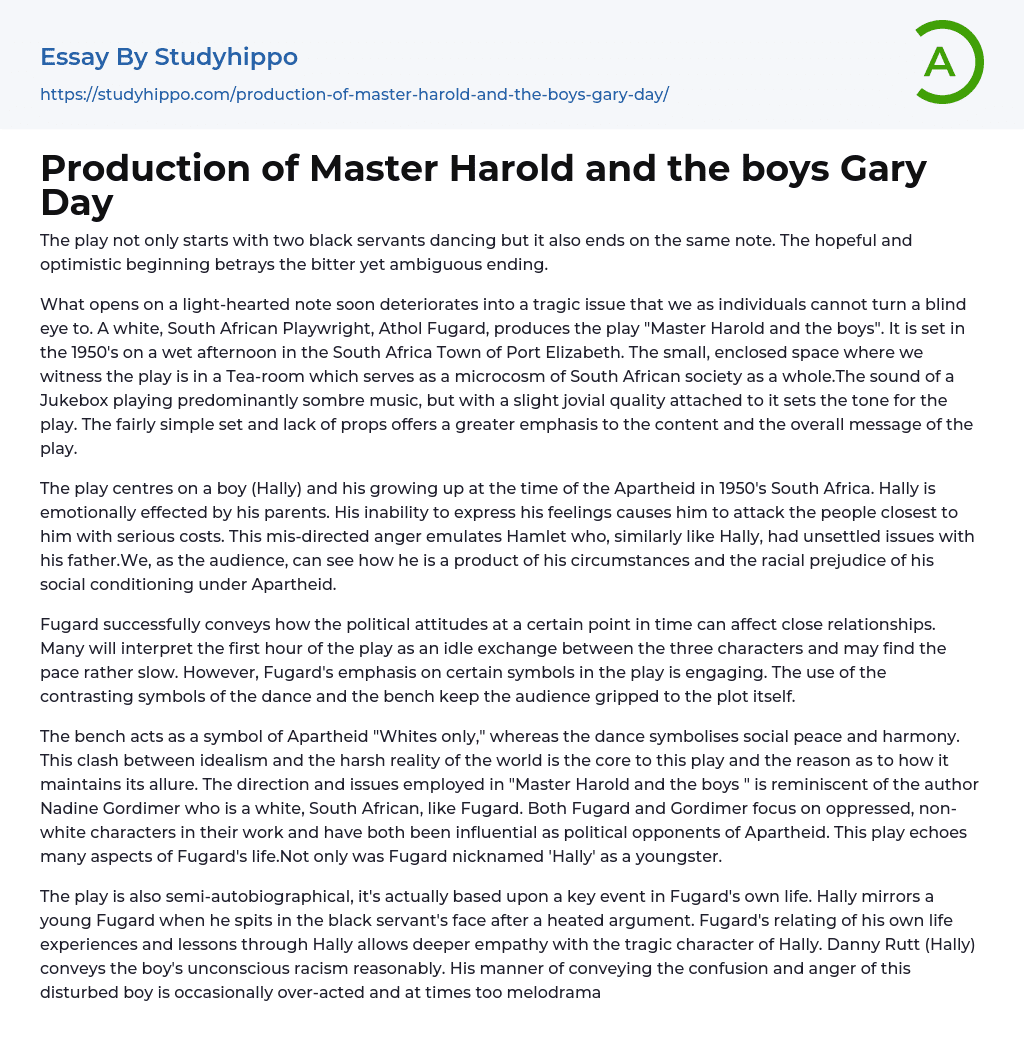

Production of Master Harold and the boys Gary Day Essay Example
The play commences with a dance performed by two black servants, and concludes on a similar tone. Although the initial tone is one of hope and positivity, the ending is bitter and uncertain.
Starting off on a lighthearted note, the play "Master Harold and the boys" by white South African playwright Athol Fugard takes a tragic turn that we can't ignore. The setting is Port Elizabeth, South Africa in the 1950s, and the action takes place in a tea-room. Despite its small size, this setting reflects larger issues in South African society. A jukebox provides the background music - mostly downbeat, but with a slightly cheerful undertone - and the simple set and lack of props place greater focus on the play's message and content.
Set during South Africa's Apartheid era in the 1950s, this play tracks young Hally's journey to adulthood. His parents' influence and his own emo
...tional struggles lead him to lash out at those closest to him, resulting in dire consequences. Like Hamlet, Hally grapples with unresolved issues surrounding his father. As observers, we witness how societal biases ingrained by Apartheid have shaped Hally's character and situation.
Fugard effectively demonstrates how the political climate can impact personal connections. Although some viewers may perceive the initial hour of the performance as languid, the playwright's incorporation of significant symbols captures the audience's attention. Specifically, the dance and bench serve as contrasting symbols that enhance the plot.
Within "Master Harold and the boys", the bench serves as a representation of Apartheid's divisive "Whites only" approach, while the dancing reflects a more hopeful vision of social unity. This contrast between idealism and the stark realities of th
world lies at the heart of the play's enduring appeal. The play's themes and direction are reminiscent of Nadine Gordimer, a fellow white South African writer, who shared Fugard's focus on marginalized non-white characters and opposition to Apartheid. Fugard drew upon his own experiences and identity for inspiration in creating this work, even having been called "Hally" as a child.
The play is based on a key event in Fugard's semi-autobiographical life, where Hally (played by Danny Rutt) mirrors a younger version of Fugard himself. After a heated argument, Hally spits in the face of a black servant. Fugard's use of his own experiences to shape Hally's character creates a deep sense of empathy for the tragic figure. While Rutt reasonably portrays Hally's unconscious racism, at times his delivery of the boy's confusion and anger can be melodramatic and over-the-top, detracting attention from Sam's passive role.
This play showcases some exceptional performances. Obano's serene demeanor is particularly noteworthy. While Rutt's dialogue is weighty, his flawed South African accent overshadows it. However, Seun Shote's portrayal of Willie adds a touch of comic relief when needed. His humorous pillow dance provides some much-needed respite from the play's dominating serious tone. That being said, Willie's everyday activities can become tedious and detract from the storyline at times.
In essence, the play features Rex Obano (Sam) in a touching role that spans the length of the performance. Through his patient expressions and gestures towards Hally, Sam's warm character is revealed. His eloquent speeches solidify his wise and composed persona. Of note is his poignant statement, "Dirtier than I've ever felt in my life," which serves as both a
powerful reminder of the enduring presence of racial conflict and a lingering lament for the issue at hand. Despite this, the question arises: how many times does the same window really need cleaning?
Throughout the play, there is a noticeable lack of balance in the attention given. The initial hour may appear dull due to repetitive discussions without any actual events taking place. As the play progresses towards its peak, it becomes more intense when Hally's deep-seated racism surfaces, leading to outbursts of anger, annoyance, and bitterness. Though this sudden burst of energy is gripping, it fails to have the intended impact because it occurs so late in the play. Consequently, the audience feels a sense of dissatisfaction at the show's conclusion. They wonder whether Hally has truly learned anything or acquired any knowledge after years of being tutored and befriended by the boys. This is where the source of true frustration lies.
- Malcolm X essays
- Black Lives Matter essays
- Antisemitism essays
- Ku Klux Klan essays
- Miscegenation essays
- Racial Segregation essays
- I Have a Dream essays
- Martin Luther King essays
- Racial Inequality essays
- Black History Month essays
- Black People essays
- Ambition essays
- Anger essays
- Betrayal essays
- Boredom essays
- Confidence essays
- Courage essays
- Desire essays
- Disgrace essays
- Doubt essays
- Empathy essays
- Fairness essays
- Fear essays
- Feeling essays
- Forgiveness essays
- Grief essays
- Guilt essays
- Happiness essays
- Harmony essays
- Hate essays
- Honesty essays
- Honor essays
- Hope essays
- Humanity essays
- Inspiration essays
- Kindness essays
- Laughter essays
- Loneliness essays
- Lost essays
- Loyalty essays
- Need essays
- Passion essays
- Pressure essays
- Pride essays
- Regret essays
- Respect essays
- Responsibility essays
- Sarcasm essays
- Shame essays
- Suffering essays



